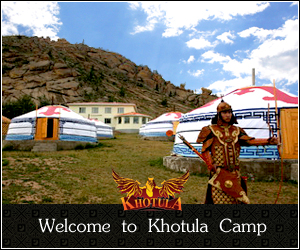The Huns Tombs Reveal New Findings
{mosimage}“The Findings of The Huns”, a work of archaeological research and analysis has recently received the certification of the best works from the Ministry of Education, Culture and Science. The findings were on exhibition under the theme of the joint work of science and production.
“The Findings of The Huns”, a work of archaeological research and analysis has recently received the certification of the best works from the Ministry of Education, Culture and Science. The findings were on exhibition under the theme of the joint work of science and production. The exhibition had findings from two places: Gol Mod in Khairkhan soum, Arkhangai aimag.
“In 1956, Dorjsuren, an archaeologist, worked there for more than a year and had first revealed the site and findings. Since then, no one had done any research until 2000, when a joint Mongolian and French team of archaeologists began research. It is one of the biggest tombs belonging to the Huns aristocrats,” said Ch. Erool-Erdene, a research worker at the Sector of the Huns studies of the Institute of Archeology. “Six other tombs like this were found from the Huns period due to the latest research.”
“As research workers, we made a map of nearby tombs in the Gol Mod area. We found there are about 420 tombs. Excavation work was done and we uncovered three big tombs.”
The tomb of a nobleman or aristocrat differs from other tombs. It has smaller tombs associated with it. “When a king dies, his servants were also buried nearby. Servant’s tombs are often found on the right side.”
Likewise, the research team has found another 15 tombs. “The tomb of a nobleman, is usually quite large compared to that of an ordinary person and is often square in shape. Its vestibule is a trapezoid form. The diameter is from 40 to 50 meters and 15-meters in depth.” Excavating a tomb is a big job that requires much energy and time, often three years.
“The tomb interior is lined with logs at its 15-meter depth.” The mausoleum has a double-parapet with a coffin made of wood. The tomb of a nobleman is richer than others because it includes clothing and other personal items. When asked if it is certain to know that servants were buried alongside their kings, “It is difficult to determine exactly as the tombs are from 2000 years ago.”
Why is it assumed that the surrounding tombs are those of servants? A reference come from ancient Chinese historical sources, in which it was written that servants were killed and then buried along with the King of the Huns. “We had not known about this before due to lack of resources. According to the results of the latest research, the bones of young people, aged 20 to 25 years old had been found”.
“We have found some interesting findings never revealed before. Almost all of the Huns era tombs have horse-carts. We assume it was a means of transportation for the deceased to enter another world in the after life.”
“We have a horse-cart with two umbrellas on top and two wheels that was used for ceremonial purposes. The craftsmanship is very good. It was made of wood and painted with red lacquer. The wheel spokes were lacquered in black.” Some scholars think that the horse-cart was not of the Huns origin, but from Khan (country) of China. “Carts from the Khan era have been found in China.”
We can also see the uniqueness of nomadic life, and a shaman period. “One interesting thing we found was that all the belongings in the tombs were broken.” Researchers believe that this was intentional so that the ghost of the deceased would go away along with them when they died.”
Numerous bronzes such as a weapon, a teapot and lacquered items were also found. “Delineated decorations of animals have received the most interest. These items were shown to several zoologists who identified them as having the bodies of reindeers with the heads of horses. Only one antler was on its forehead. This animal was also delineated with wings in another example, as though it were flying.” “We also have a board game, which is the first game found in the country.” Other interesting findings are a silk deel (Mongolian national costume), shoes, hat, utensils made of silver, bronze and clay, wooden cup, gold and silver artifacts and fur.
Written by Ts.Lkhagvasuren
The UB Post












